
Rudelsburg
Encyclopedia
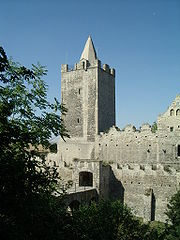
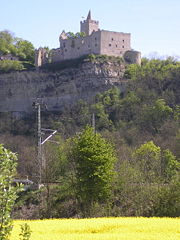
Saale
The Saale, also known as the Saxon Saale and Thuringian Saale , is a river in Germany and a left-bank tributary of the Elbe. It is not to be confused with the smaller Franconian Saale, a right-bank tributary of the Main, or the Saale in Lower Saxony, a tributary of the Leine.-Course:The Saale...
atop a rocky shell limestone ridge, approximately 85 metres (279 ft) above the river and above Saaleck, a suburb of the town of Bad Kösen
Bad Kösen
' is a spa town in Germany, on the Saale river in the small German wine-growing region of Saale-Unstrut. It is a former municipality in the Burgenlandkreis district, in Saxony-Anhalt...
in the Burgenlandkreis
Burgenlandkreis
The Burgenlandkreis was a district in the south of Saxony-Anhalt, Germany. Neighboring districts are Merseburg-Querfurt, Weißenfels, Leipziger Land, Aschersleben-Staßfurt, Altenburger Land, Greiz, district-free Gera, Saale-Holzland, Weimarer Land, Sömmerda and the Kyffhäuserkreis.- History :The...
district in Saxony-Anhalt
Saxony-Anhalt
Saxony-Anhalt is a landlocked state of Germany. Its capital is Magdeburg and it is surrounded by the German states of Lower Saxony, Brandenburg, Saxony, and Thuringia.Saxony-Anhalt covers an area of...
, Germany
Germany
Germany , officially the Federal Republic of Germany , is a federal parliamentary republic in Europe. The country consists of 16 states while the capital and largest city is Berlin. Germany covers an area of 357,021 km2 and has a largely temperate seasonal climate...
. The Rudelsburg was built in the Middle Ages
Middle Ages
The Middle Ages is a periodization of European history from the 5th century to the 15th century. The Middle Ages follows the fall of the Western Roman Empire in 476 and precedes the Early Modern Era. It is the middle period of a three-period division of Western history: Classic, Medieval and Modern...
by the Bishop of Naumburg
Naumburg
Naumburg is a town in Germany, on the Saale River. It is in the district Burgenlandkreis in the Bundesland of Saxony-Anhalt. It is approximately southwest of Leipzig, south-southwest of Halle, and north-northeast of Jena....
and served to secure trade routes such as the Via Regia
Via Regia
Via Regia, i.e. "Royal Highway", denotes a mediæval historic road. The term, in the usual sense, means not just a specific road, rather a type of road. It was legally associated with the king and remained under his special protection and guarantee of public peace.There were many such roads in the...
through the Saale Valley.
The Rudelsburg was a point of conflict between the bishops of Naumburg
Naumburg
Naumburg is a town in Germany, on the Saale River. It is in the district Burgenlandkreis in the Bundesland of Saxony-Anhalt. It is approximately southwest of Leipzig, south-southwest of Halle, and north-northeast of Jena....
and the Margraves of Meissen belonging to the House of Wettin. The castle occasionally served various noble families as a residence, until it was destroyed in the Thirty Years' War
Thirty Years' War
The Thirty Years' War was fought primarily in what is now Germany, and at various points involved most countries in Europe. It was one of the most destructive conflicts in European history....
and thereafter fell into disrepair. In the early 19th century the Rudelsburg became a popular tourist destination thanks to the romanticisation of mountains and the rise of hiking as a pastime. It was considered one of the most beautiful of the castles on the river Saale and exceeded mere regional fame from 1855 onwards as the annual meeting place of the Kösener Senioren-Convents-Verband
Kösener Senioren-Convents-Verband
The Kösener Senioren-Convents-Verband is the oldest association of German and Austrian Studentenverbindungen. It comprises roughly 105 German, Austrian and a Swiss Corps, all of which are based upon the principle of tolerance....
, the oldest union of student fraternities with delegates from all German-speaking countries
German-speaking Europe
The German language is spoken in a number of countries and territories in West, Central and Eastern Europe...
. The Rudelsburg still represents a particular attraction and lies on the southward course of the Romanesque Road (Ger
German language
German is a West Germanic language, related to and classified alongside English and Dutch. With an estimated 90 – 98 million native speakers, German is one of the world's major languages and is the most widely-spoken first language in the European Union....
:Straße der Romanik), a holiday route in Saxony-Anhalt
Saxony-Anhalt
Saxony-Anhalt is a landlocked state of Germany. Its capital is Magdeburg and it is surrounded by the German states of Lower Saxony, Brandenburg, Saxony, and Thuringia.Saxony-Anhalt covers an area of...
.
Architecture

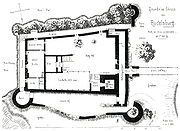
Ward (fortification)
In fortifications, a bailey or ward refers to a courtyard enclosed by a curtain wall. In particular, an early type of European castle was known as a Motte-and-bailey. Castles can have more than one ward. Their layout depends both on the local topography and the level of fortification technology...
divided into several sections and surrounded by an outer ward
Ward (fortification)
In fortifications, a bailey or ward refers to a courtyard enclosed by a curtain wall. In particular, an early type of European castle was known as a Motte-and-bailey. Castles can have more than one ward. Their layout depends both on the local topography and the level of fortification technology...
. The stones of the outer ward were largely reused in the 18th century and it is no longer recognisable; only parts of the wall in the east and south are still there. The outer ward was unusual to the extent that it was built higher up than the central ward was.
The central ward, which was separated from the ward keep by a deep encircling ditch, has a bergfried
Bergfried
A bergfried is a tall tower typically found in medieval castles in German-speaking countries . Its defensive function is to some extent similar to that of a keep or donjon in English or French castles...
that is approximately 20 metres (66 ft) high, a transverse rectangular great hall
Great hall
A great hall is the main room of a royal palace, nobleman's castle or a large manor house in the Middle Ages, and in the country houses of the 16th and early 17th centuries. At that time the word great simply meant big, and had not acquired its modern connotations of excellence...
, several living quarters, and is surrounded by a circular wall. The courtyard is very small.
The Romanesque
Romanesque architecture
Romanesque architecture is an architectural style of Medieval Europe characterised by semi-circular arches. There is no consensus for the beginning date of the Romanesque architecture, with proposals ranging from the 6th to the 10th century. It developed in the 12th century into the Gothic style,...
bergfried is almost exactly square (7.6 m (24.9 ft) by 8.2 m (26.9 ft)) and is topped with a pyramid-shaped tower roof made of stone, which gives the castle its characteristic appearance. There is a dungeon
Dungeon
A dungeon is a room or cell in which prisoners are held, especially underground. Dungeons are generally associated with medieval castles, though their association with torture probably belongs more to the Renaissance period...
in the basement of the donjon.
The outer palisade
Palisade
A palisade is a steel or wooden fence or wall of variable height, usually used as a defensive structure.- Typical construction :Typical construction consisted of small or mid sized tree trunks aligned vertically, with no spacing in between. The trunks were sharpened or pointed at the top, and were...
s in the east were constructed in the 13th century, the other palisades and the circular corner towers were constructed in the 15th century. The Rudelsburg palisade, which is located between the central and outer keeps, was obviously envisaged during the construction of the castle and is seen as proof that the idea of palisades did not first arrive in Europe as a result of the Crusades
Crusades
The Crusades were a series of religious wars, blessed by the Pope and the Catholic Church with the main goal of restoring Christian access to the holy places in and near Jerusalem...
.
Because of its position atop a steep cliff above the Saale, the western side of the castle was the hardest to attack. It is protected only by the circular wall and the great hall is also located on this side.
The northern circular wall was not built on the very edge of the cliff, in contrast to the practice elsewhere in Europe. This was presumably done so as to avoid the wall collapsing if a section of the fragile limestone were to break off. The wall is set back about 1.5 metre, which made the later addition of an advanced corner tower on the north-east side necessary in order to prevent potential enemies from advancing onto this ledge.
The southern side, which is only protected by a small valley, has an additional palisade, which is flanked by two corner towers. The strongest corner tower is on the south-east side. The eastern side looks to the outer keep and is protected by the ditch, a palisade and the donjon.
At some point in time, a windmill was attached to one of the round castle towers. The windmill is shown in many depictions of the castle until the middle of the 19th century. It was destroyed by fire in 1864.
Prehistory: Early Bronze Age settlement
Archaeological finds seem to indicate that an early Bronze AgeBronze Age
The Bronze Age is a period characterized by the use of copper and its alloy bronze as the chief hard materials in the manufacture of some implements and weapons. Chronologically, it stands between the Stone Age and Iron Age...
settlement existed on the site of the Rudelsburg, which has been attributed to the Unetice culture
Unetice culture
Unetice; or more properly Únětice culture ; is the name given to an early Bronze Age culture, preceded by the Beaker culture and followed by the Tumulus culture. It was named after finds at site in Únětice, northwest of Prague. It is focused around the Czech Republic, southern and central Germany,...
. The discovery of the Nebra skydisk
Nebra skydisk
The Nebra Sky Disk is a bronze disk of around 30 cm diameter, with a blue-green patina and inlaid with gold symbols. These are interpreted generally as a sun or full moon, a lunar crescent, and stars . Two golden arcs along the sides, marking the angle between the solstices, were added later...
attracted public attention to this prehistoric civilisation and its elevated culture and provoked interest in the settlements in the region of Saxony-Anhalt and Thuringia
Thuringia
The Free State of Thuringia is a state of Germany, located in the central part of the country.It has an area of and 2.29 million inhabitants, making it the sixth smallest by area and the fifth smallest by population of Germany's sixteen states....
. The political, religious and economic importance of such settlements has not yet been established, but is the focus of intense research.
The department for pre-history and early history of the Friedrich Schiller University of Jena
Friedrich Schiller University of Jena
Friedrich Schiller University of Jena , is a public research university located in Jena, Thuringia, Germany....
has been conducting archaeological surveys in the area around the outer keep since 2005. The project (“The hill settlements of the micro and macro region - economic, socio-political, administrative and religious points of importance”, module A3 “Departure for new horizons. The finds of Nebra, Saxony-Anhalt and their importance for the European Bronze Age”) is supported by the Deutsche Forschungsgemeinschaft
Deutsche Forschungsgemeinschaft
The Deutsche Forschungsgemeinschaft is an important German research funding organization and the largest such organization in Europe.-Function:...
. Below the layers of Middle Age residue, which are at times up to 3.5 metre deep, researchers have documented prehistoric finds in the layers of loess
Loess
Loess is an aeolian sediment formed by the accumulation of wind-blown silt, typically in the 20–50 micrometre size range, twenty percent or less clay and the balance equal parts sand and silt that are loosely cemented by calcium carbonate...
. The discovery of prehistoric ceramic products amongst the layers left behind in the Middle Ages however indicates considerable disturbance of the prehistoric residue and therefore also of the finds dating back to the Unetice culture. The project ended in 2007.
Military fortification and seat of nobility
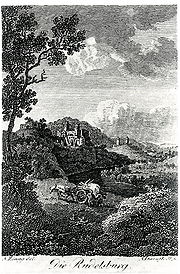
Heinrich III, Margrave of Meissen, received the castle from the Bishop from Naumburg in 1238 as recompense for services to the church and installed there a number of families belonging to the nobility of service (retainers to a lord whose status was far above that of the peasantry but who nonetheless did not belong to the ranks of the high nobility). A source from 1271 names 12 different castellan
Castellan
A castellan was the governor or captain of a castle. The word stems from the Latin Castellanus, derived from castellum "castle". Also known as a constable.-Duties:...
s. A priest
Priest
A priest is a person authorized to perform the sacred rites of a religion, especially as a mediatory agent between humans and deities. They also have the authority or power to administer religious rites; in particular, rites of sacrifice to, and propitiation of, a deity or deities...
is mentioned for the first time in 1293.
During a dispute with the noble Curtefrund, the citizens of Naumburg led by their captain Johann von Trautzschen laid siege to the Rudelsburg from 22 April to 30 July 1348. The sources relate that an “instrumentum” was brought to bear during the siege that could shoot Greek fire
Greek fire
Greek fire was an incendiary weapon used by the Byzantine Empire. The Byzantines typically used it in naval battles to great effect as it could continue burning while floating on water....
. This must have been some early form of gunpowder and is thought to be one of the first records of the use of firearms in a siege
Siege
A siege is a military blockade of a city or fortress with the intent of conquering by attrition or assault. The term derives from sedere, Latin for "to sit". Generally speaking, siege warfare is a form of constant, low intensity conflict characterized by one party holding a strong, static...
in Germany
Germany
Germany , officially the Federal Republic of Germany , is a federal parliamentary republic in Europe. The country consists of 16 states while the capital and largest city is Berlin. Germany covers an area of 357,021 km2 and has a largely temperate seasonal climate...
. The only earlier recorded use of ordnance dates back to the siege of the town of Meersburg
Meersburg
Meersburg is a town of Baden-Württemberg in the southwest of Germany at Lake Constance.It is famous for its charming medieval city. The lower town and upper town are reserved for pedestrians only and connected by two stairways and a steep street .-History:The name of the town means "Burg on the...
on Lake Constance
Lake Constance
Lake Constance is a lake on the Rhine at the northern foot of the Alps, and consists of three bodies of water: the Obersee , the Untersee , and a connecting stretch of the Rhine, called the Seerhein.The lake is situated in Germany, Switzerland and Austria near the Alps...
by Ludwig von Bayern
Louis IV, Holy Roman Emperor
Louis IV , called the Bavarian, of the house of Wittelsbach, was the King of Germany from 1314, the King of Italy from 1327 and the Holy Roman Emperor from 1328....
in 1334. The oldest reports in all of Europe are from Italy
Italy
Italy , officially the Italian Republic languages]] under the European Charter for Regional or Minority Languages. In each of these, Italy's official name is as follows:;;;;;;;;), is a unitary parliamentary republic in South-Central Europe. To the north it borders France, Switzerland, Austria and...
(Florence
Florence
Florence is the capital city of the Italian region of Tuscany and of the province of Florence. It is the most populous city in Tuscany, with approximately 370,000 inhabitants, expanding to over 1.5 million in the metropolitan area....
1326, Cividale 1331) and from the French fleet (1338-1346).
The citizens of Naumburg burnt the Rudelsburg down during their siege, and there were deaths and injuries on both sides. It seems that the castle was not rebuilt, as it is not mentioned in any official document for several decades after this event.
The next mention of the castle dates to 1383, when the Schenk family from Saaleck belonging to the House of Vargula are named as masters of the citadel, seated in Rottelsburg.
A loan certificate of the Dukes of Saxony, who belonged to the House of Wettin, dated 2 April 1441 names the brothers Rudolf, Günther and Heinrich von Bünau as the owners of the Rudelsburg. Apparently they owned no land other than that on which the castle stood.
During the fratricidal war
Saxon Fratricidal War
The Saxon Fratricidal War was a war fought between the two brothers Frederick II, Elector of Saxony and Duke William III over Wettin ruled areas from 1446 to 1451...
between Friedrich
Frederick II, Elector of Saxony
Frederick II was Elector of Saxony and was Landgrave of Thuringia .-Biography:...
and Wilhelm of Saxony
William III, Duke of Luxembourg
William III of Luxembourg , called the Brave , was Landgrave of Thuringia and Duke of Luxemburg...
, the Rudelsburg was besieged and destroyed for a second time in 1450. The inner keep was burnt to the ground during this incident.
At the division of the lands of the House of Wettin in 1485, the Rudelsburg was attributed to the Albertine line.
Rudolph von Bünau auf Teuchern
Teuchern
Teuchern is a town in the Burgenlandkreis district, in Saxony-Anhalt, Germany. It is situated approx. 10 km southeast of Weißenfels....
and Günther von Bünau auf Gröbitz
Gröbitz
Gröbitz is a village and a former municipality in the district Burgenlandkreis, in Saxony-Anhalt, Germany. Since 1 January 2011, it is part of the town Teuchern....
sold the Rudelsburg and the surrounding outwork
Outwork
An outwork is a minor defense, fortification, built or established outside the principal fortification limits, detached or semidetached. Outworks were developed in the 16th century, such as ravelins, lunettes , caponiers to shield bastions and fortification curtains from direct battery...
s to Hans Georg von Osterhausen in 1581 to cover their debts. The castle, which had been barely maintained until then, began to fall into decay during this period.
Although Groitzsch still describes the Rudelsburg as “arx pulcherrima” (“most beautiful castle”) in his 1585 work Descriptio Salae fluvii eidemque adjacentium urbium, arcium etc. (Description of the river Saale and the surrounding towns, castles, etc.), a record from 1612 indicates that the lord marshal of Osterhausen zu Dresden
Dresden
Dresden is the capital city of the Free State of Saxony in Germany. It is situated in a valley on the River Elbe, near the Czech border. The Dresden conurbation is part of the Saxon Triangle metropolitan area....
employed a stonemason and a carpenter to provide “necessary support of the sagging beams, girders and rafters”.
According to Osterhausen court records, a process was held at the Rudelsburg on the 4th of June 1616. At the time, a caretaker still lived in the castle, which was accessible via a narrow road. The courtyard was covered in grass. Besides a small room with a wooden pulpit, the usable remains of the castle included the dungeons with their very strong doors.
Towards the end of the Thirty Years’ War in 1640, Swedes set fire to the Rudelsburg. Following this third destruction, the Rudelsburg was abandoned on 14 April 1641 and the inhabitants moved to the nearby Kreipitzsch property.
The nobles from Creutz(en) are believed to have been the owners of the Rudelsburg from 1671 to 1771. In 1690, they tried to establish the status of the (uninhabited) castle as a possession owing direct allegiance only to the emperor (Reichsunmittelbarkeit) in a court process in the imperial court in Wetzlar
Wetzlar
Wetzlar is a city in the state of Hesse, Germany. Located at 8° 30′ E, 50° 34′ N, Wetzlar straddles the river Lahn and is on the German Timber-Framework Road which passes mile upon mile of half-timbered houses. Historically, the city has acted as the hub of the Lahn-Dill-Kreis on the north edge of...
.
In 1770, the owner of the Rudelsburg ordered that the walls of the outer keep be torn down in order to reuse the stones for construction on the property, but a worker was permanently injured in an accident, and this was interpreted as a bad omen. The work was stopped. The outer keep was almost completely destroyed at this point in time, and it is probably only as a result of this accident that the ruined inner keep was preserved.
With the death of Friedrich Adolph von Creutz, the lord of Hesse
Hesse
Hesse or Hessia is both a cultural region of Germany and the name of an individual German state.* The cultural region of Hesse includes both the State of Hesse and the area known as Rhenish Hesse in the neighbouring Rhineland-Palatinate state...
, in 1774, the male line of the family was extinguished. This thwarted the plans to establish the Reichsunmittelbarkeit of the Rudelsburg.
In the following years, the counts from Zech and the counts from Brühl are named briefly as the owners of the Rudelsburg. The family von Schönberg bought the castle in 1797 and established an entailment, i.e. an indivisible trust that was designed to keep together the inheritance of the family.
The Rudelsburg as a destination for hikers and a tourist attraction

Jena
Jena is a university city in central Germany on the river Saale. It has a population of approx. 103,000 and is the second largest city in the federal state of Thuringia, after Erfurt.-History:Jena was first mentioned in an 1182 document...
, Leipzig
Leipzig
Leipzig Leipzig has always been a trade city, situated during the time of the Holy Roman Empire at the intersection of the Via Regia and Via Imperii, two important trade routes. At one time, Leipzig was one of the major European centres of learning and culture in fields such as music and publishing...
and Halle
Halle, Saxony-Anhalt
Halle is the largest city in the German state of Saxony-Anhalt. It is also called Halle an der Saale in order to distinguish it from the town of Halle in North Rhine-Westphalia...
.
By this time, the castle was desolate, and devoid of all infrastructure. There was no entrance into the courtyard of the central keep and there were no sealed rooms, just rubble and debris. In 1818, the cantor emeritus, Johann Friedrich Förtsch, described the Rudelsburg as follows:
“The inner courtyard is covered in the rubble of the various ceremonial halls, chambers, weapon and storage rooms, kitchens, underground vaults, cellars and corridors, which have collapsed. It is thus impossible to say how everything used to be arranged.”
Nonetheless, ever more visitors came to the Rudelsburg. During the same period, the masters of the castle belonging to the family of the barons von Schönberg planted grapevines on the southern slope of the hill. One of the former vineyard workers, Gottlieb Wagner, known as “Samiel”, began to look after the ruins. From 1824 onwards, he offered food and drink from the Kreipitzsch property to visitors.

Franz Kugler
Franz Theodor Kugler was a cultural administrator for the Prussian state and art historian...
, a student from Stettin studying in Berlin
Berlin
Berlin is the capital city of Germany and is one of the 16 states of Germany. With a population of 3.45 million people, Berlin is Germany's largest city. It is the second most populous city proper and the seventh most populous urban area in the European Union...
, composed the famous song “An der Saale hellem Strande” (On the bright bank of the Saale) whilst resting at the castle during a hike along the river in 1826:
|

The attractiveness of the castle rose however with the services offered by Wagner, so much so that the head of the district authorities in Naumburg asked Friedrich von Schönberg, the owner of the property, if it would be possible to open it officially for visitors. Consequently, a road was even built up to the castle.
Gottlieb Wagner opened the first tavern in the castle in time for Easter
Easter
Easter is the central feast in the Christian liturgical year. According to the Canonical gospels, Jesus rose from the dead on the third day after his crucifixion. His resurrection is celebrated on Easter Day or Easter Sunday...
, 1827, although it was only open on Sundays at first. When word got around about this development amongst the students in Jena, they marched on the Rudelsburg and, cheering loudly, occupied it for three days. The owner of the castle was honoured with a torchlight procession.
The completion of the Thuringian Railway in 1849, which improved the access to the Rudelsburg, coupled with the gastronomic offerings, further increased the attractiveness of the castle and brought in visitors from further abroad, including for example students from Leipzig and Halle an der Saale.
During a large-scale Prussia
Prussia
Prussia was a German kingdom and historic state originating out of the Duchy of Prussia and the Margraviate of Brandenburg. For centuries, the House of Hohenzollern ruled Prussia, successfully expanding its size by way of an unusually well-organized and effective army. Prussia shaped the history...
n military manoeuvre in the area in 1853, the provincial classes invited King Frederick William IV to breakfast at the castle. The drinking hall in the inner courtyard, which was built in the same year, is probably a product of this visit. The hall took the form of a roofed seating area that was open to the courtyard and replaced the old straw roof that had been held up by simple tree trunks.

Hermann Allmers
Hermann Allmers was a German poet.He was an only child, and was privately tutored. He began his career in public education, but took over the family farm after the death of his father in 1849....
from Rechtenfleth near Bremen
Bremen
The City Municipality of Bremen is a Hanseatic city in northwestern Germany. A commercial and industrial city with a major port on the river Weser, Bremen is part of the Bremen-Oldenburg metropolitan area . Bremen is the second most populous city in North Germany and tenth in Germany.Bremen is...
composed the student song “Dort Saaleck, hier die Rudelsburg” (There Saaleck, here the Rudelsburg). Although Allmers was himself not a student, he traveled with students in the Saale valley, and his song speaks of the new life within the walls of the castle.
|
|
In the middle of the 19th century, the Rudelsburg became a regular meeting point for students’ corps, whose umbrella organisation the Kösener Senioren-Convents-Verband
Kösener Senioren-Convents-Verband
The Kösener Senioren-Convents-Verband is the oldest association of German and Austrian Studentenverbindungen. It comprises roughly 105 German, Austrian and a Swiss Corps, all of which are based upon the principle of tolerance....
(KSCV) had been founded in Jena in 1848, making it the oldest union of German student fraternities. The site of the KSCV’s annual meeting was soon moved to Bad Kösen, and a meeting took place in the Rudelsburg for the first time in 1855. From this time until World War I
World War I
World War I , which was predominantly called the World War or the Great War from its occurrence until 1939, and the First World War or World War I thereafter, was a major war centred in Europe that began on 28 July 1914 and lasted until 11 November 1918...
, the Rudelburg served every year as a social meeting point during the annual meeting in Bad Kösen.
(Re-)construction under the Empire

Wartburg
The Wartburg is a castle overlooking the town of Eisenach, Germany.Wartburg may also refer to:* Wartburgkreis, a district in Germany named after the Wartburg* Wartburg , former East German brand of automobiles, manufactured in Eisenach...
, discussions began as to whether the Rudelsburg should also be restored. These discussions were further provoked by a storm in December 1868, which brought down parts of the perimeter walls. Work to restore the perimeter walls in the west and in the south began in 1870. The partial reconstruction of the castle began a year later under the leadership of the master builder, Werner, from Bad Kösen, using plans drawn up by the royal building officer in Saxony, Oskar Mothes. During these works, the entrance and the bridge were repaired. The knight’s hall with its staircase and side room were restored. A large breach in the wall was closed in the north-eastern corner and windows were cut in the old northern wall. A canon that had been captured in the 1870-71 Franco-Prussian War
Franco-Prussian War
The Franco-Prussian War or Franco-German War, often referred to in France as the 1870 War was a conflict between the Second French Empire and the Kingdom of Prussia. Prussia was aided by the North German Confederation, of which it was a member, and the South German states of Baden, Württemberg and...
was placed on the bridge. These works were complete by Easter 1872.
In 1872, the first monument erected by members of the students’ corps was unveiled. The Gefallenensäule (English: Pillar to the Fallen) was established in honour of those members who had fallen in the Franco-Prussian War
Franco-Prussian War
The Franco-Prussian War or Franco-German War, often referred to in France as the 1870 War was a conflict between the Second French Empire and the Kingdom of Prussia. Prussia was aided by the North German Confederation, of which it was a member, and the South German states of Baden, Württemberg and...
. The Emperor William I Obelisk was unveiled in 1890, followed in 1896 by the Young Bismarck Memorial. The last of this first round of monuments was erected in 1926 in honour of those who fell in World War I.
(See below: Monuments)
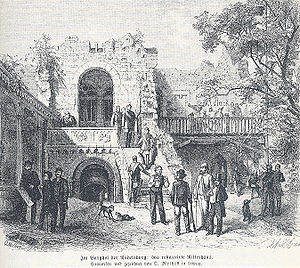
German Empire
The German Empire refers to Germany during the "Second Reich" period from the unification of Germany and proclamation of Wilhelm I as German Emperor on 18 January 1871, to 1918, when it became a federal republic after defeat in World War I and the abdication of the Emperor, Wilhelm II.The German...
in 1871 and the erection of the monuments in the area near the outer keep marked a completely new phase in the history of the Rudelsburg. While youthful appreciation of nature and the romantic scenery had been pivotal in the first half of the century, the Rudelsburg now became a symbol for the members of the KSCV. The KSCV was a strong ally of the state, which was reinforced by the membership of both of the most important political decision-makers of the time, Otto von Bismarck
Otto von Bismarck
Otto Eduard Leopold, Prince of Bismarck, Duke of Lauenburg , simply known as Otto von Bismarck, was a Prussian-German statesman whose actions unified Germany, made it a major player in world affairs, and created a balance of power that kept Europe at peace after 1871.As Minister President of...
and Emperor William II. With the founding of the Verband Alter Corpsstudenten (English: Federation of old members), the KSCV, which had until then only counted students amongst its members, had a new source of income in the form of contributions from the “old men”. The Rudelsburg became a platform for celebrations of the KSCV’s new self-confidence. As a consequence, the annual meeting at the Rudelsburg became more sedate and ceremonial. Speeches held at the monuments and patriotic songs were fixtures in the annual Pentecost
Pentecost
Pentecost is a prominent feast in the calendar of Ancient Israel celebrating the giving of the Law on Sinai, and also later in the Christian liturgical year commemorating the descent of the Holy Spirit upon the disciples of Christ after the Resurrection of Jesus...
programme in the German Empire.
In the Empire and the Weimar Republic
Weimar Republic
The Weimar Republic is the name given by historians to the parliamentary republic established in 1919 in Germany to replace the imperial form of government...
, life-size copies of the Rudelsburg monuments were made and sold to interested buyers in Germany
Germany
Germany , officially the Federal Republic of Germany , is a federal parliamentary republic in Europe. The country consists of 16 states while the capital and largest city is Berlin. Germany covers an area of 357,021 km2 and has a largely temperate seasonal climate...
and Austria
Austria
Austria , officially the Republic of Austria , is a landlocked country of roughly 8.4 million people in Central Europe. It is bordered by the Czech Republic and Germany to the north, Slovakia and Hungary to the east, Slovenia and Italy to the south, and Switzerland and Liechtenstein to the...
. In 2007, these laboriously produced objects are still to be found from time to time in antique shops.
In 1913, Paul Schreckenbach wrote the historical novel “The last Rudelsburger”, which is set in the 14th century and which reflects the conservative Prussian values of his time.
Weimar Republic and National Socialism
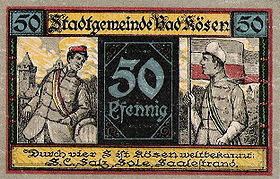
World War I
World War I , which was predominantly called the World War or the Great War from its occurrence until 1939, and the First World War or World War I thereafter, was a major war centred in Europe that began on 28 July 1914 and lasted until 11 November 1918...
, but the tradition was restarted after the end of the war. In 1926, the Löwendenkmal (English: Lion Monument) was unveiled with great pomp. This ceremony was seen as a symbol of the members of the students’ corps attachment to the old imperial system and was reported throughout Germany and beyond.
The last meeting of the KSCV at the Rudelsburg before World War II
World War II
World War II, or the Second World War , was a global conflict lasting from 1939 to 1945, involving most of the world's nations—including all of the great powers—eventually forming two opposing military alliances: the Allies and the Axis...
took place in 1934. The 1935 congress ended with the dissolution of the group by the National Socialists.
During World War II
World War II
World War II, or the Second World War , was a global conflict lasting from 1939 to 1945, involving most of the world's nations—including all of the great powers—eventually forming two opposing military alliances: the Allies and the Axis...
, there were efforts at some universities to re-establish individual student bodies in secret. These were to include the umbrella organisation, the KSCV. To this end, a meeting was organised at the Rudelsburg in 1944, which ended with a ceremonial drinking session. Because of the chaos in the last months of the war, neither this new founding nor the attraction of the Gestapo
Gestapo
The Gestapo was the official secret police of Nazi Germany. Beginning on 20 April 1934, it was under the administration of the SS leader Heinrich Himmler in his position as Chief of German Police...
’s attention had serious consequences for those involved.
After the end of World War II, the Rudelsburg was part of the Soviet occupation zone and later the German Democratic Republic
German Democratic Republic
The German Democratic Republic , informally called East Germany by West Germany and other countries, was a socialist state established in 1949 in the Soviet zone of occupied Germany, including East Berlin of the Allied-occupied capital city...
(GDR). The owner, a member of the nobility, lost his possessions, and the castle was attributed to the town of Bad Kösen.
In the GDR

Würzburg
Würzburg is a city in the region of Franconia which lies in the northern tip of Bavaria, Germany. Located at the Main River, it is the capital of the Regierungsbezirk Lower Franconia. The regional dialect is Franconian....
, near to the Fortress Marienberg
Fortress Marienberg
Fortress Marienberg is a prominent landmark on the Main river in Würzburg, Germany. The mighty Fortress Marienberg is the symbol of Würzburg and served as a home of the prince-bishops for nearly five centuries. It has been a fort since ancient times...
. The Rudelsburg and Bad Kösen were but a memory for the members of the students’ corps.
The Rudelsburg decayed further during this time, as did the monuments that had been erected there. Some larger metal pieces were melted down and reused.
As it was common to take the names of tourist attractions to designate products produced in a particular area, the name “Rudelsburg” was used to name a car radio produced in the state-owned radio factory in Halle and various products produced in the equally state-owned limestone factory in Bad Kösen.
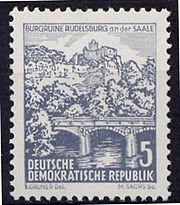
On 20 June 1987, the fraternity Salana Jenensis organised the first ceremonial drinking session of the GDR student fraternities at the Rudelsburg. At the first such meeting, just 19 participants were present, some of whom had arrived by using rafts or bath tubs made of zinc to travel along the Saale. This was to be a reference to the tradition of boat trips on the Saale which can be seen in many old depictions. This ceremonial drinking session was the first officially registered traditional student meeting in the history of the GDR.
From this year on, the Rudelsburg was the annual meeting point for the student fraternities which had been founded in the GDR before 1990. In 1990, they joined together in the Rudelsburg Alliance.
Reconstruction after German Reunification
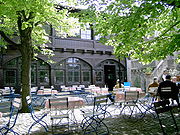
German reunification
German reunification was the process in 1990 in which the German Democratic Republic joined the Federal Republic of Germany , and when Berlin reunited into a single city, as provided by its then Grundgesetz constitution Article 23. The start of this process is commonly referred by Germans as die...
), the first student bodies began to return to their old university towns in the GDR. The first congress took place in Bad Kösen in 1995. The Rudelsburg was once again put to use for this purpose, which required extensive work to restore the castle. Bad Kösen’s infrastructure also had to be upgraded, for the congress was now much larger than it had even been before the war.
The monuments at the Rudelsburg have also been successively restored since unification. These works have been financed by the KSCV, with donations from individual student bodies, but also with donations from individual members.
The song “Dort Saaleck, hier die Rudelsburg” is still used by members of both the KSCV and the Rudelsburg Alliance.
The Rudelsburg still hosts a restaurant. The inner area of the castle and the donjon are accessible during the opening hours of the restaurant and visitors have a view of the Saale valley from the donjon. In the lower rooms of the donjon, there are display windows with exhibits about the student organisations.
So that weddings may take place there, there is a civil registry office in the castle. The town Bad Kösen and the surrounding districts now market the castle as part of the “Thuringian Toscana”, including the nature reserve Saale-Unstrut-Triasland.
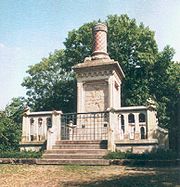
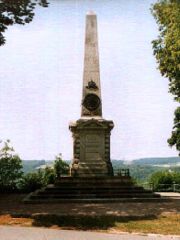

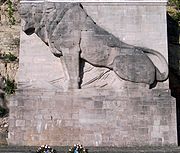
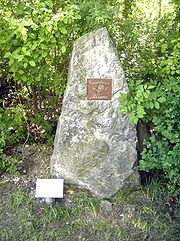
Monuments
In the course of time, many monuments have been erected at the Rudelsburg. Four important monuments have been put up just by the KSCV on the way from Bad Kösen to the Rudelsburg on the land formerly occupied by the outer keep.Pillar to the Fallen
The Pillar to the Fallen was erected at Pentecost in 1872 in honour of the members of the students’ corps who had fallen in the 1870-1871 Franco-Prussian WarFranco-Prussian War
The Franco-Prussian War or Franco-German War, often referred to in France as the 1870 War was a conflict between the Second French Empire and the Kingdom of Prussia. Prussia was aided by the North German Confederation, of which it was a member, and the South German states of Baden, Württemberg and...
. The students put up this monument without the help of the “old men”, whose federation had not yet been founded, and the Pillar was in fact the first monument ever erected by students in Germany. It consisted of a base with stairs, a platform with balustrade, a four-metre tall pedestal and a pillar topped by an imperial eagle with a crown. The monument was destroyed in 1953, under the GDR.
Emperor William I Obelisk
The Emperor William I Obelisk was unveiled on the 25th of May 1890. It honours the German Emperor, who died in 1888. It too was destroyed under the GDR, but was erected anew following the Reunification.Young Bismarck Monument
The Young Bismarck Monument was the first project to be realised by the Verband Alter Corpsstudenten. It was erected in 1895-96 to commemorate the 80th birthday of Prince Otto von BismarckOtto von Bismarck
Otto Eduard Leopold, Prince of Bismarck, Duke of Lauenburg , simply known as Otto von Bismarck, was a Prussian-German statesman whose actions unified Germany, made it a major player in world affairs, and created a balance of power that kept Europe at peace after 1871.As Minister President of...
, he himself an “old man” of the Corps Hannovera Göttingen
Corps Hannovera Göttingen
thumb|Bismarck 1836The Corps Hannovera Göttingen is one of the oldest German Student Corps, a Studentenverbindung or student corporation founded 18 January 1809 at the Georg August University of Göttingen by students like Georg Kloss. The name was chosen because the founders had their home...
. Of the countless Bismarck monuments erected in Germany, this was the only one that depicted the first Imperial Chancellor as a nonchalantly seated young man with the sash of his fraternity across his chest and a duelling sword in his hand. This portrayal of Bismarck in a casual stance provoked heated discussions, but had been approved by Bismarck himself on the 27 April 1895. It is the work of sculptor Prof. Norbert Pfretzschner. This monument was destroyed under the GDR by the Free German Youth
Free German Youth
The Free German Youth, also known as the FDJ , was the official socialist youth movement of the German Democratic Republic and the Socialist Unity Party of Germany....
, but the foundation stone with inscriptions and Bismarck’s student hat was saved by members of East German student fraternities and handed over to the KSCV after the Reunification. On the 29th of May 1998, members of the Corps Hannovera Göttingen paid for a memorial to be erected on the site of the old Bismarck monument.
A reproduction of the original monument was unveiled by the KSCV on 1 April 2006 in the presence of the Justice Minister of Saxony-Anhalt, Curt Becker. Andreas Belser from Traunstein
Traunstein
Traunstein is a town in the south-eastern part of Bavaria, Germany, and is the administrative center of a district by the same name. It is situated at the heart of a region called Chiemgau, approximately 11 km east of Lake Chiemsee between Munich and Salzburg, 15 km north of the Alps, and...
was the responsible sculptor and the casting had been carried out by the firm Otto Strehle in Winhöring
Winhöring
Winhöring is a municipality in the district of Altötting in Bavaria in Germany.Winhöring is the starting point of the famous federal road 588 to Eggenfelden. No federal road in Germany has a higher reference number than this road. Winhöring also features a bewitched castle in the middle of a...
near Altötting
Altötting
Altötting is a town in Bavaria, capital of the district Altötting.This small town is famous for the Gnadenkapelle , one of the most-visited shrines in Germany. This is a tiny octagonal chapel which keeps a venerated statue of the Virgin Mary...
. Many members of the Corps Hannovera who had been involved in the realisation and financing of the reproduction were present at the ceremonial unveiling of the monument. The monument has however already been damaged by souvenir hunters or vandals.
Lion Monument
The Lion Monument was erected in 1926 in memory of the 2,360 members of the KSCV who had fallen in World War IWorld War I
World War I , which was predominantly called the World War or the Great War from its occurrence until 1939, and the First World War or World War I thereafter, was a major war centred in Europe that began on 28 July 1914 and lasted until 11 November 1918...
. It shows in relief an oversized lion that has been pierced with lances and is dying.
The Lion Monument was created by Professor Hermann Hosaeus (1875–1958), a sculptor from Berlin. After the Reunification, the overgrown monument was restored and new plaques in memory of those who fell in both World Wars were added.
Alliance Stone
The Alliance Stone was erected at the Rudelsburg in 1997 by members of the Rudelsburger Alliance to commemorate the tenth anniversary of the first official meeting of student fraternities in the GDR. An earlier stone made of concrete had been placed next to the Bismarck Monument in 1987. This “Old Alliance Stone” is still in its original place.Further reading
- Carl Peter Lepsius: Die Ruinen der Rudelsburg. Naumburg: Bürger, 1824.
- Paul Wilhelm Corssen: Die Rudelsburg: Den Besuchern der Burg zur Nachricht. 2nd Ed . Naumburg: H. Sieling, 1869.
- Paul Salvisberg: Die Rudelsburg: Eine Reisestudie mit Text und Original-Zeichnungen, nebst einer Einleitung über die Entwicklung der Mittelalterlichen Militair-Architectur in Deutschland. Stuttgart: In Commissionsverlag bey Konrad Wittwer, 1879.
- Otto Piper, Burgenkunde. Bauwesen und Geschichte der Burgen zunächst innerhalb des deutschen Sprachgebietes, 3rd Ed, Würzburg 1912, pages 10, 12, 13, 85, 134, 149, 192, 223, 249, 289, 293, 391, 392, 401, 454, 456, 584
- Deutsche Burgenvereinigung (ed.), Burgen in Mitteleuropa. Ein Handbuch, Stuttgart 1999
- Vol I Bauformen und Entwicklung, pages 227, 244, 272, 275
- Vol II Geschichte und Burgenlandschaften, pages 190, 192, 193, 201, illustration 84
- Reinhard Schmidt: Zur Geschichte und Baugeschichte der Rudelsburg, Burgenlandkreis. In: Burgen und Schlösser in Sachsen-Anhalt 14 (2005), S. 75-153.
- August von Cohausen, Die Befestigungsweisen der Vorzeit und des Mittelalters, Würzburg 2003
- III. Teil Mittelalterliche Befestigungen deutscher Burgen, Seite 156; Figur 196
- Rüdiger Kutz, Die Chronik der Rudelsburg und ihrer Denkmäler, München 1993. In: Einst und Jetzt Sonderheft 1993 (Jahrbuch des Vereins für corpsstudentische Geschichtsforschung)

